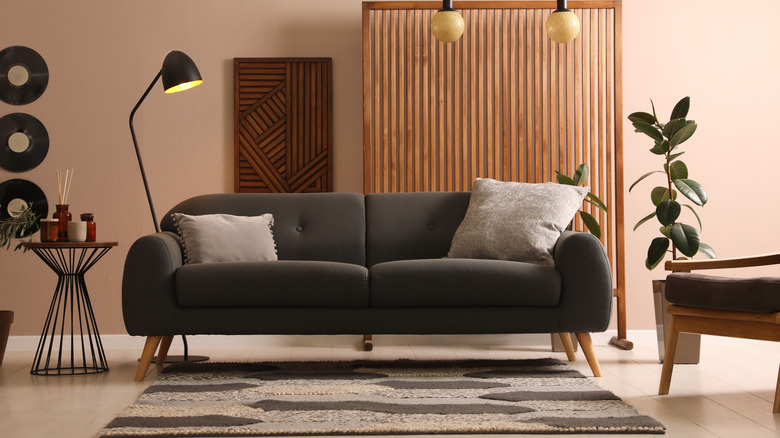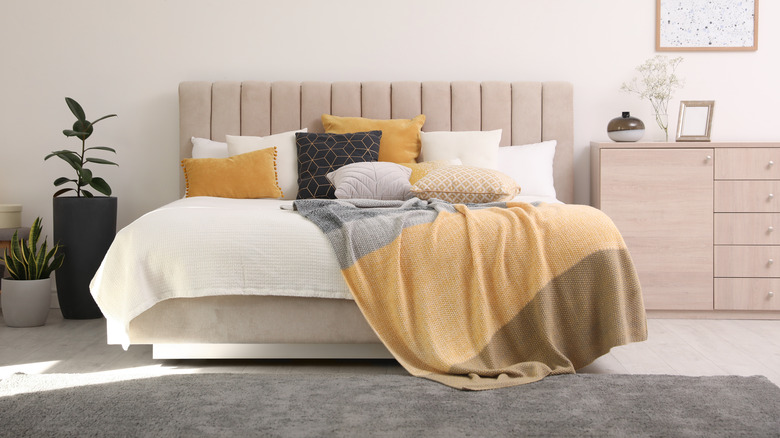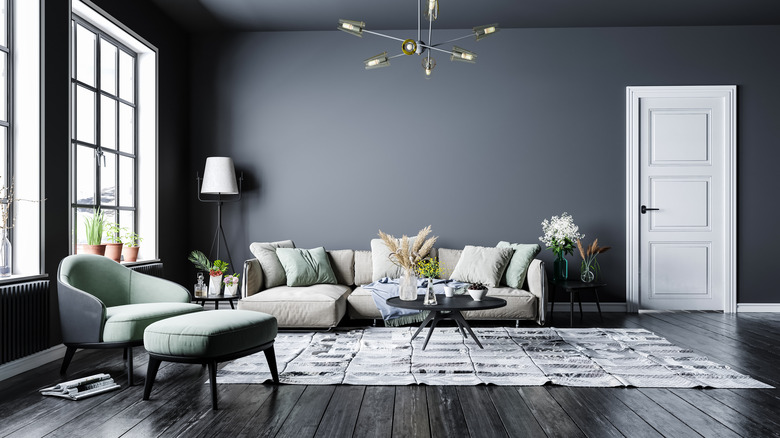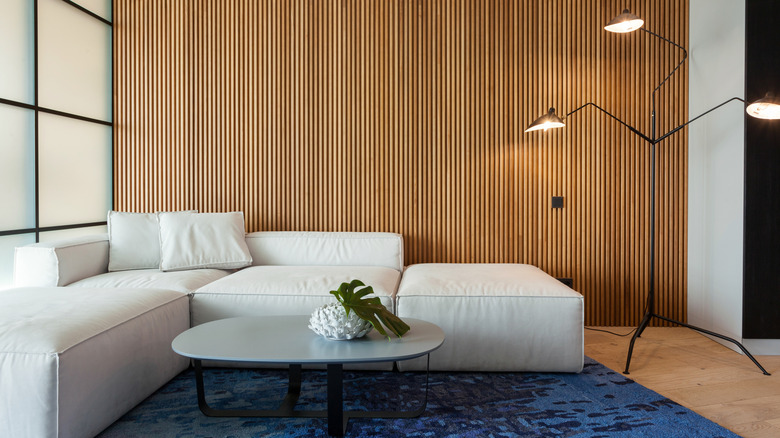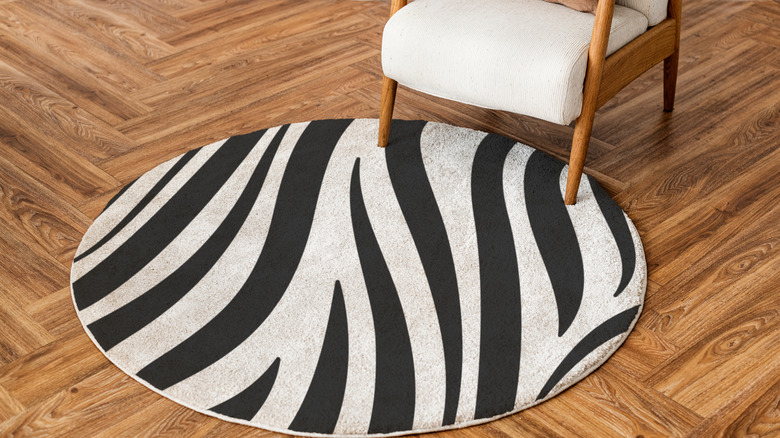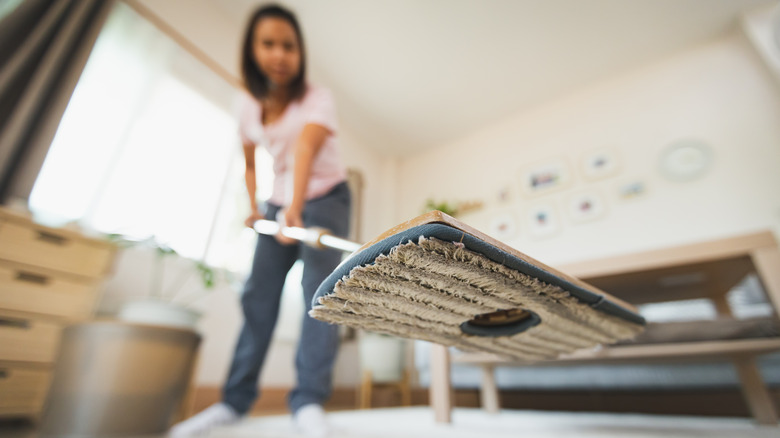5 Savvy Tips For Decorating With Rugs
When furnishing a home, the rug is often treated as a throwaway detail not carefully factored into the greater design plan. You've browsed couches, chairs, coffee tables, and TV stands. But the rug is often left for last. In the interest of design cohesion, this is a mistake. The wrong rug can make a room feel unnerving. And a missing rug can make a room feel incomplete. In fact, Real Simple points out that forgetting a rug is one of the main design mistakes homeowners make with spacious floor plans.
It is helpful to treat the rug as the palette on which you build the room around. With so many different textures, colors, and styles, rugs can create drama, contrast, and comfort. If a room is a painting, treat your rug selection as the landscape within which you fill your foreground. Now, we are going to dive into five tips for nailing this process and taking your home to the next level.
1. Measure the room
In addition to taking measurements for your furniture dimensions, it can be helpful to take rug measurements before you buy any furniture. By doing this, a clear sense of scale and clarity can be defined by how the rug will fit in the room. Expansive rugs can increase the perceived size of a room. When using a rug as a palette for a given room, this greater exposure allows the eye to soak up the rug's relationship to the other pieces of furniture with even greater detail.
In this regard, some of the typical dimensions for rugs are 5' x 8', 8” x 10', and 9' x 12' (as noted by Redekers). Although measurements can still leave a homeowner unsure about the size, here is one option for mitigating that concern. With each measurement, lay down a three or four-inch piece of tape to mark each corner. It's a great design hack that can give you the full sense of the rug's size, and you can also utilize this technique with furniture measurements as well.
2. Consider the floors
In a living room, homeowners are usually choosing between one of two sensibilities: light and airy or dark and cozy. The rug plays a huge factor in this decision-making process but can often be the detail that makes or breaks this objective. If the objective is light and airy, more likely than not, the floors are going to be lighter, such as a white oakwood floor. For floors like these, Carpet To Go recommends lower contrast colors such as cream, dusty rose, and olive green to create that easy on the eye and relaxing sensibility.
If the objective is dark and cozy, darker floors work wonderfully with charcoal, subdued or darkened reds and oranges, and whites for contrast. Light floors can be dark and cozy, and dark floors can be light and airy. But the rug choice will play a role in creating that aesthetic. Light rugs brighten rooms, and dark rugs darken rooms. By making sure that the floor and rug color palettes are working in harmony, the room now has an excellent starting point for furnishing the rest.
3. Complement, but do not match
One of the mistakes first-time homebuyers make when furnishing a house is that they attempt to match every shade, tone, and pattern perfectly. Though color harmony is important to home design, overdoing it can create a dull and uninteresting room. This also applies to the selection of a rug. A rug can either complement a low contrast environment or offer something dynamic in a high contrast environment. In a low contrast environment, this might mean pairing white walls and light wood floors with a beige or neutral rug with some pattering, as seen in Plank & Pillow.
But the color of the rug should be a bit lighter or darker than the floor selection. And the pattern of the rug should not match the pattern of the bedroom pillows. In a high-contrast environment, this problem is more easily avoided. For example, black walls and dark flooring pair spectacularly with a charcoal orange or red rug, as noted on MyMove. Even in a high contrast environment, complementary pairings such as these can make any room feel bigger, more interesting, and intriguing to the eye.
4. Style and utility
When choosing a rug for any room, consider the room and the aesthetic objectives. For example, Shelley Moore from Hunker notes that bold and bright colors and patterns, including dark colors, will add coziness to a larger room by taking up some of the space. And it's true. Intense and super saturated rugs draw the eye away from area. This design technique could be helpful in a hallway, for example, when you want to shrink the perceived space between two rooms and create flow. Utilizing something funky like a mid-century modern rug or a playful southwestern style rug could be a helpful technique in this situation.
Or perhaps there is a living room for a young family, and the homeowners are looking for a low-maintenance rug that hides stains well. In this instance, something like a nautical or Moroccan style rug, which has a relaxed but also sophisticated quality, could be a nice compromise for the parents and the children, as seen on Overstock. Both often come in earth tones and navies and, thus, also hide stains well.
5. Use a pad
When laying down a rug, it is essential to account for the condition and health of the floors. If the room is carpeted, this is less of an issue when choosing a rug. However, it is important to lay down a rug pad between hard flooring and the rug. Excessive shuffling of the rug can knock into furniture, scratch flooring, and potentially cause injury to the user. Decor Outdoor notes that by laying these grips in between the flooring and the rug, you will also be able to relocate the rug when needed. It will just minimize any of the other issues from arising.
Ultimately, these kinds of measures are important when designing a rug and its respective layout. Consider the logistics of accessing the space underneath the rug for cleaning, as well. It may inform how heavy of a coffee table or sofa that you purchase or make you think differently about how you configure a room.
